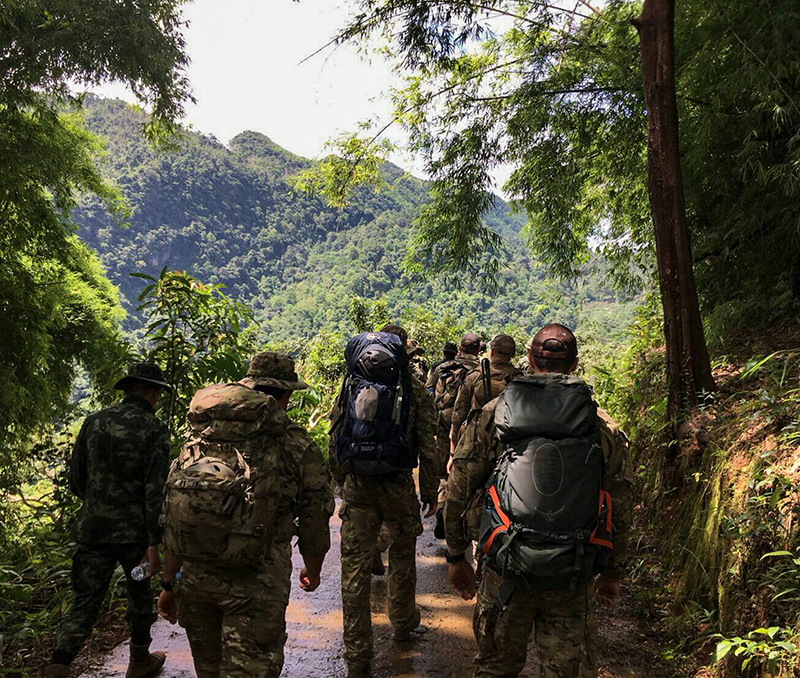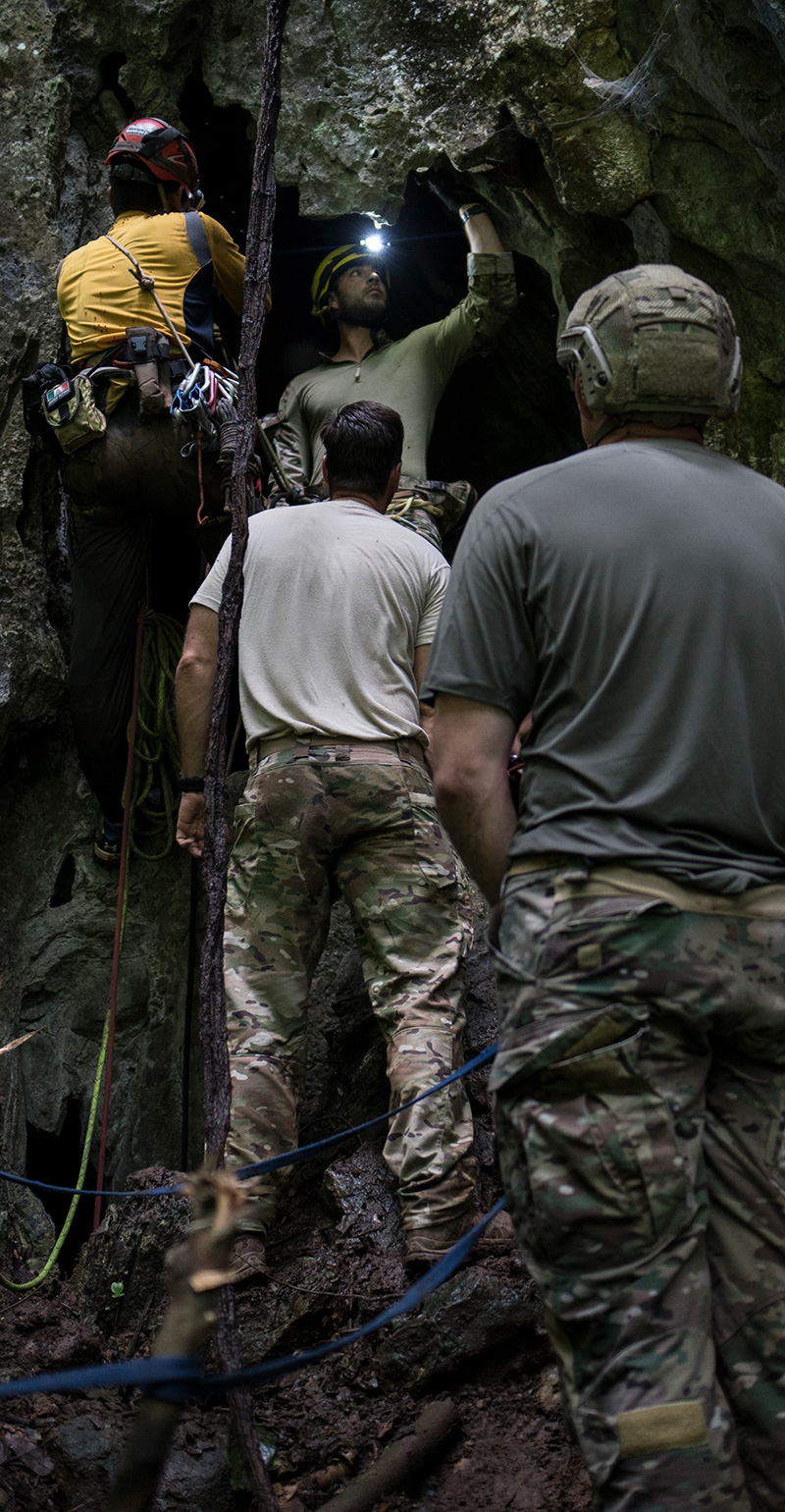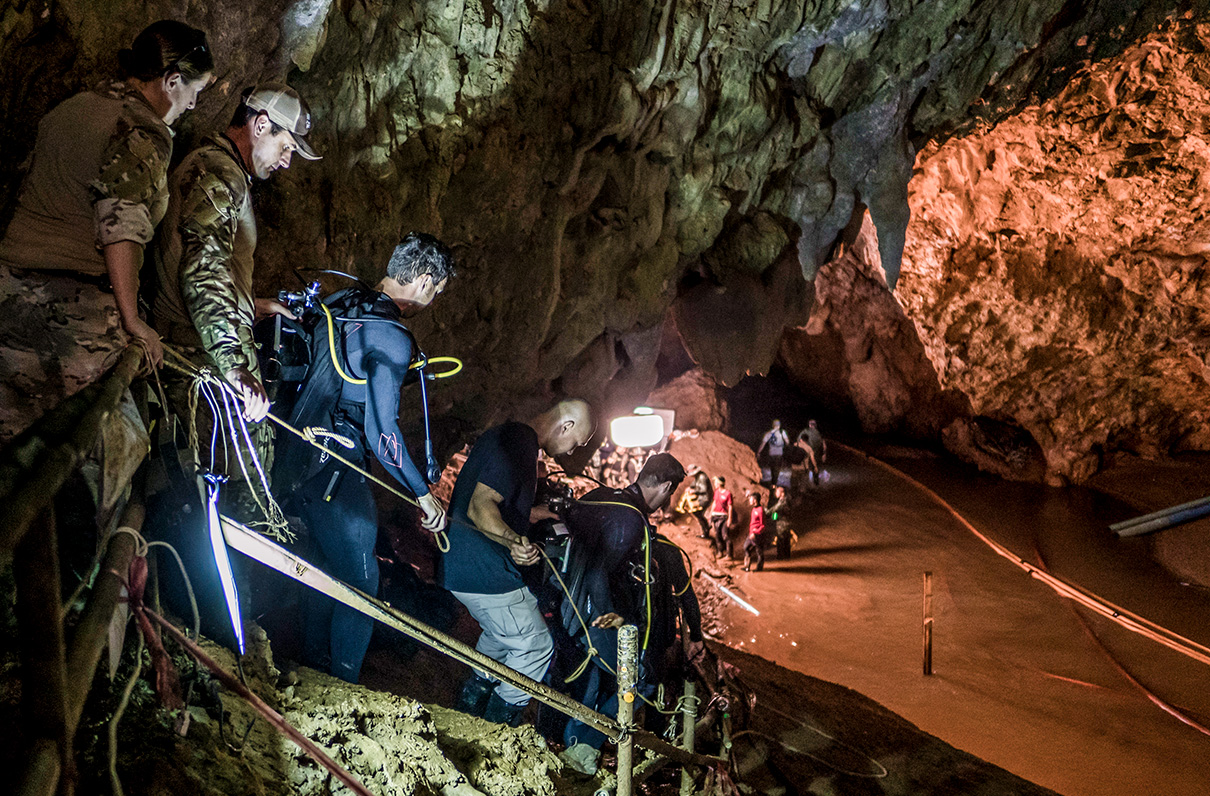(This article originally appeared in Military Officer, a magazine available to all MOAA Premium and Life members. Learn more about the magazine here; learn more about joining MOAA here.)
Twelve boys rode their bicycles to a cave June 23 in Thailand. Dropping their bikes at its mouth, they followed their 25-year-old soccer coach on a team-building exercise. But heavy rains partially flooded the cave system, forcing the group to retreat further inside for higher ground. Eventually, they were trapped in Tham Luang Nang Non, a cave that rescuers didn't quite understand.
As information about the structure of the cave trickled in, rescuers were challenged to devise a rescue plan for a dark space, parts of which are no bigger than a man's rib cage. The Thai government called the U.S. Indo-Pacific Command for help. Here's how the Air Force's 320th Special Tactics Squadron led U.S. efforts in the
mission.
The Call
Air Force Staff Sgt. James Brisbin, a search-and-rescue expert, was winding down a family vacation in late June when he received a call saying his obscure cave-diving skills were needed.
Brisbin said goodbye to his family at the Kyoto, Japan, airport. He and his team were bound for Thailand.
About 40 Air Force pararescuemen boarded the plane June 28. There were more airmen than seats on the plane, forcing some into the cockpit.
“I think everyone that was there while it was going on kind of realized they were involved in something - maybe once-in-a-lifetime,” Brisbin says. “People were honored, … and they were lucky enough to be in the right place at the right time.”
Pararescuemen spend two years rigorously training to perform high-angle rescues - rope rescues such as in mountains or underwater - so they can respond to crises in desert, mountain, jungle, or urban environments, or any situation requiring a trauma or medical specialist.
They do not routinely plan for cave-diving missions, but that didn't discourage them from responding when Thailand asked for help.
Surveying the Situation
The next day, Thai special forces led the American responders to the entrance of the cave, noting water-filled sumps - hollow, narrow pathways underneath rock. To navigate through a sump, a person would have to wade, duck, crawl, or dive, and swim through it.
Vern Unsworth, a British man who lives near the cave in Thailand, met the teams. Unsworth recently completed a map of the cave, estimating it to be one of the longest cave systems in the world, with very narrow passages in spots.
Making Contact
On July 2, two British divers made it through the cramped, flooded passages in the cave and found the boys alive. They were sitting together on a rock about 2 miles inside the cave. Thai rescuers immediately began plotting ways to get the group out.
Among the biggest challenges for rescuers was the fact that they had limited communication and sight.
Rescuers had a Vietnam War-era field telephone that could withstand the water and mud in the cave, says Maj. Charlie Hodges, commander of the Air Force's 320th Special Tactics Squadron. They also set up a wireless internet signal and were able to use WhatsApp, a text message app, in a portion of the cave.
Hodges said rescuers could yell and use arm signals to communicate to others in the same chamber, but it was nearly impossible to communicate with rescuers in other chambers. They relied on rope movement.
Navigating the dark, winding cave was another big challenge. Rescuers described a tunnel filled with rocks and random boulders. Sometimes the space was large, but some spaces were so tight rescuers had to remove their dive gear and worm their way through.

Photo by U.S. Air Force Captain Jessica Tait
Rescue Rehearsal
With a final plan approved by Thailand's Minister of the Interior, rescuers began rehearsal drills, setting up chairs - strung together with rope - to mark different sections of the cave, based on information from Unsworth and British divers.
They marked water bottles with green tape to indicate where the children and coach would move. They marked another set of bottles with blue tape for the air tanks of rescuers. Bottles with red tape helped the rescuers note empty and discarded air tanks along the path.
Specific areas of the cave were chronologically numbered from one to nine. The mouth of the cave was Chamber 1; the stranded soccer team was in Chamber 9.
The plan called for each boy to be escorted out by one or more divers. The children would be sedated for the trip to prevent them from panicking and endangering themslves and their rescuers.
During rehearsals, rescuers noted it would take about three hours to get a single child from their perch in Chamber 9 to Chamber 3. One of the most dangerous stretches of the path would require a diver and child to be submerged for about 30 minutes. Throughout the entire path, rescuers would have to contort their bodies, along with the child they were carrying, to make it through tight passageways.
The rescue team was concerned that if a child were too far away from their diver escort, they could collide against rock, dislodging their face mask and causing them to drown. They also were concerned about low oxygen levels and cold temperatures that could trigger hypothermia.
Rescuers realized the only way to tell if a boy were alive during the dive likely would be if he moved or bubbles came out of his face mask.
After the children learned basic swimming and diving skills, rescue teams moved into position. The mission launched July 8.
Battle Stations
Rescue teams were stationed at different chambers along the rescue path. Chambers 4-8 were manned by the “Euro divers,” as they were nicknamed by the team. U.S. airmen were assigned to Chamber 3, with Thai SEALs.
Brisbin and Staff Sgt. John Merchand were assigned to Sump 3, positioned between Chamber 3 and Chamber 2, along with additional Thai SEALs. The U.S. airmen built a rope system through Chambers 2 and 3 to guide divers out.
Rescuers in Chamber 1 were from Australian, Chinese, Thai, and U.S. teams. Ambulances parked near the mouth of the cave, waiting to transport the children and their coach to a nearby hospital.
Executing the Plan
With preparations and rehearsals complete, the first boy was administered a sedative before two diving escorts moved him from Chamber 9 to Chamber 3, where Air Force Tech Sgt. Ken O'Brien was waiting.
O'Brien pulled the child from the exhausted diver, raised him out of the water, flipped him onto his side, and placed his ear to the boy's face mask.
The chamber fell silent as the pararescuemen wondered whether their first rescue attempt had been successful.
O'Brien gave a thumbs-up. “He's good,” he said, quickly moving him to the next station.
The boy was put on a rope-and-pulley-operated litter. He was maneuvered through three massive boulders and onto a plateau, where a Thai SEAL recovered the boy and rechecked his vital signs.
Still on the litter, the boy was moved down a 45-degree slope to Sump 3, where Brisbin and Merchand were waiting.
Brisbin and Merchand navigated the boy through the semi-submerged, 65-foot Sump 3 and up a chimney into Chamber 2.
Thai SEALs and U.S. pararescuemen received the boy there and maneuvered through another challenging rope section and two short, semi-submerged sumps to Chamber 1.
The first rescue was a success. Eleven more followed - but not without incident.
One Close Call
Midway through the recovery, rescuers from one chamber sent a WhatsApp message to the follow-on chamber: “fish on the line,” their signal that a diver had just taken off with a boy.
At that section of the cave, it was expected to take about 15 minutes to reach the follow-on chamber.
Fifteen minutes passed with no movement on the rope. Then 30 minutes passed; still nothing.
Brisbin, who was waiting for the boy, remembers thinking about how successful the rescuers had been already. His heart sank, wondering if they had their first fatality.
“This was out of the ordinary,” Brisbin says, remembering the rescue. “Everything was going smoothly. We'd have a 'fish on the line,' then 15 minutes later, we'd be moving through Chamber 3 and Chamber 2, so that [delay] was definitely nerve-racking.”
About an hour later, the divers and boy emerged from the murky water. Rescuers learned the lead escort had lost the guide rope. He and the boy he was escorting had to hold in place until their follow-on escort caught up to them.
“It's an underwater labyrinth with no light,” Brisbin says. “And even if you did have light, you can't see what you're holding onto anyway.”

Photo by U.S. Air Force Captain Jessica Tait
An Officer's Reflection
Hodges reflects on the mission, grinning as he thinks about the officers who taught him to lead troops through the most-dire missions. Be bold and take risks, they told him.
“We absolutely took risks,” Hodges says. “We thought that it was going to turn out positive, but we candidly did not think it would turn out that positive. My senior leadership has given me the opportunity to advise and assist the Thai, we're going to take appropriate risks and be bold, and my guys knocked it out of the park.”
Post-Rescue Mission
Rescuers remained at the cave to break down equipment and clean up. They understood how unpredictable the weather was, and any slight move of rocks or boulders could be perilous.
U.S. personnel and Thai SEALs who were assigned to Chamber Three had to wait two hours after the last boy was rescued to move their move. The wait was required so the water quality could improve and ensure the Thai SEALs, who swim faster than the children, wouldn't run out of oxygen waiting on the rescuers to get the children through to the exit.
So they started their stopwatches.
Capt. Mitch Torrel, USAF, stationed in Chamber Three, noticed some of the extra air tanks were removed from the cave during the equipment break down and cleaning. He expressed concern that many people thought the mission was over, even though the Thai SEALs still needed to get through the cave. Just as he had sensed, disaster struck.
Two Thai SEALs were moving from a sump into Chamber Three. They waited on a third Thai SEAL when a massive water pump broke, causing the sump and Chamber Three to start filling with water.
If the sump became full submerged with water, only those people with oxygen tanks - which were limited since so many had been removed - would survive.
Rescuers near the broken water pump yelled to those in Chamber Three.
“Landslide! Landslide! Landslide!,” they screamed.
That was the code word for an emergency, triggering rescuers to immediately seek safe ground.
Torrel, O'Brien, and Thai SEALS helped moved everyone out as the third Thai SEAL popped out of the water. A forth Thai SEAL was right behind him, he said.
Torrel and O'Brien were among the last out, tilting their heads back with their lips puckered, scraping the roof of the sump. They were clinging to the last bit of air pocket left in the sump that was swiftly filling with water.
They reached safety and turned around, waiting for the third and fourth Thai SEALs, who were behind them with oxygen tanks. The SEALs traversed the now fully submerged sump safely. All of the rescuers made it out safely.
After-Action Meeting
Through the garbled mash of English and Thai, one thing was clear: Bliss.
It wasn't the words spoken, but the sentiment felt by the elite U.S. Air Force pararescuemen standing face-to-face with the Thai mothers and fathers of 12 boys they had miraculously helped rescue from a flooded cave.
“We did have the opportunity … to meet with the families of the boys and the coach that were rescued that day and that was a really fulfilling event,” said Maj. Charlie Hodges, commander of the Air Force's 320th Special Tactics Squadron that led the US efforts in the mission. “So even though it was relatively short - it was 10 minutes or so - and their English was just as bad as my Thai so we needed a translator to help out with that - it was very gratifying to see their expressions and see the looks in their eyes and get that verbal and non-verbal thanks and just to be a part of that.”
Amanda Dolasinski is a staff writer for Military Officer. She can be reached at amandad@moa.org. Follow her on Twitter @AmandaMOAA.
